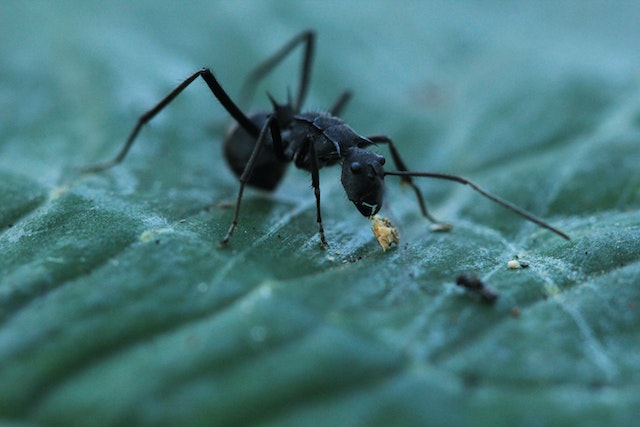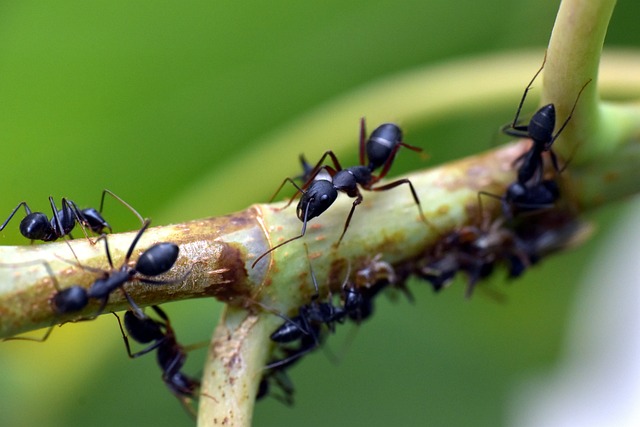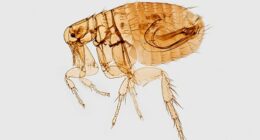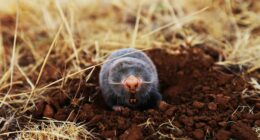Carpenter ants are larger, excavate wood to create nests, and can cause structural damage, Black ants are smaller, nest in soil or cracks, and are primarily scavengers, foraging for food inside and outside homes.
TL;DR Carpenter ants Vs. Black ants
Carpenter ants are larger in size and often have a reddish or black coloration. They are known for their ability to excavate wood and create nests within wooden structures. Black ants come in various species but are generally smaller than carpenter ants and typically black or dark brown in color.
What are carpenter ants?

Carpenter ants, known scientifically as camponotus spp, do not actually eat wood but instead excavate galleries within it to create their nests. These nests often consist of interconnected tunnels and chambers where the colony can thrive.
One identifying characteristic of carpenter ants is their size – they can range from 1/4 inch to 3/4 inch in length. They come in various colors, including black, red, brown, or a combination thereof.
Another distinguishing feature is their segmented body with a narrow waist called a “petiole.” This petiole separates the thorax from the abdomen and gives them an ant-like appearance.
Carpenter ants prefer moist environments and are commonly found nesting in damp or decaying wood. Indoors, they may infest wooden structures such as walls, window frames, or even furniture. Outdoors, they may establish nests in tree stumps or rotting logs.
What are black ants?

Black ants, also known as common house ants or pavement ants, are a widespread species found in many parts of the world. These small insects typically measure about 1/8 to 1/4 inch in length and are usually black or dark brown in color.
Black ants live in colonies that can contain thousands of individuals. They build their nests in various locations such as under rocks, in cracks and crevices, or even inside buildings. Their nests are often hidden and difficult to detect.
Black ants have a diverse diet that includes sugary substances like nectar and honeydew from plants, as well as other insects, dead animals, and food scraps left by humans. They possess strong mandibles which they use to cut through obstacles and carry food back to their nest.
Black ants communicate with each other using pheromones – chemical signals that they leave behind for others to follow. This helps them navigate between different food sources efficiently.
While black ants can become a nuisance when they invade homes searching for food, they generally do not cause major structural damage like carpenter ants do. However, it is important to address any infestations promptly before they become more difficult to control.
Carpenter ants Vs. Black ants – Key differences
| Aspect | Carpenter Ants | Black Ants |
|---|---|---|
| Physical Appearance | Larger in size, ranging from ¼ to ½ inch | Smaller in size, typically 1/8 to ¼ inch |
| Color | Usually black, reddish, or a combination | Typically black or dark brown |
| Nesting Behavior | Excavate wood to create nests inside structures | Build nests in soil, under rocks, or in cracks |
| Habitat | Found both indoors and outdoors | Primarily found outdoors, fewer indoor infestations |
| Diet | Omnivorous, feeding on both plant and animal matter | Primarily scavengers, consuming various food sources |
| Destructive Behavior | Can cause structural damage to wooden buildings | Generally not destructive to property or structures |
| Antenna Shape | Antennae have an elbow bend | Antennae are straight |
| Colony Size | Smaller colonies, usually a few thousand ants | Larger colonies, sometimes tens of thousands |
| Behavior | Exhibit aggressive behavior when disturbed | Generally less aggressive in response to disturbances |
Are carpenter ants and black ants considered pests?
Yes, both carpenter ants and black ants can be considered pests, depending on the context and location of their presence.
Carpenter ants: Carpenter ants are considered pests when they infest homes, buildings, or other structures.
They can excavate wood to create their nests, potentially causing structural damage over time. While they do not eat wood like termites, their nesting behavior can weaken wooden structures.
Black ants: Black ants can also be considered pests when they invade homes or buildings in search of food and. They can be attracted to various food sources inside the house, leading to unwanted ant trails and potential contamination of food items.
In their natural outdoor environments, both carpenter ants and black ants play important roles in ecosystems. However, when they establish nests or forage indoors, they can become problematic for homeowners and businesses.
Controlling ant infestations often involves identifying the ant species and employing integrated pest management (IPM) techniques to mitigate their presence while minimizing environmental impact.
How to get rid of black ants?
- Identify the entry points: Locate the points where the ants are entering your home. Common entry points include cracks in walls, gaps around doors and windows.
- Clean thoroughly: Keep your living areas clean and free of food crumbs and spills. Wipe down surfaces, sweep floors, and clean up spills promptly.
- Seal entry points: Use caulk or weatherstripping to seal cracks and gaps where ants may be entering your home.
- Remove food sources: Store food in airtight containers, especially sweets and other items that attract ants. Keep pet food dishes clean and pick up any spilled pet food.
- Use vinegar: Mix equal parts of white vinegar and water and use it to wipe down surfaces. The strong smell of vinegar can deter ants.
- Natural repellents: Some natural repellents like peppermint oil, cinnamon, or citrus peels can deter ants. Place these items near ant entry points or areas with ant activity.
- Follow ant trails: Observe ant trails to identify the nest location. You can then apply ant-specific insecticides directly to the nest for more targeted control.
- Seek professional help: If the ant infestation persists despite your efforts, consider contacting a pest control professional. They can identify the ant species, assess the extent of the infestation, and implement appropriate treatments.
Remember, it’s essential to use pesticides and insecticides safely and according to the product’s instructions. If you have concerns about using chemicals, opt for non-toxic or natural solutions. Regular preventive measures can also help to keep ants from returning to your living spaces.
How to get rid of carpenter ants?
- Identify the nest: Locate the carpenter ant nest by observing their activity. Look for sawdust-like material (frass) around holes or openings in wood.
- Remove food sources: Like other ants, carpenter ants are attracted to food. Keep your living areas clean and free of food crumbs and spills.
- Seal entry points: Use caulk or weatherstripping to seal cracks and gaps in walls, doors, and windows to prevent ants from entering your home.
- Trim vegetation: Carpenter ants often use branches or vegetation to access buildings. Trim trees and shrubs that touch or overhang your home.
- Apply insecticides: If the infestation is severe and other methods haven’t worked, you may need to use insecticides specifically labeled for carpenter ant control. Follow the instructions carefully and apply them directly to the nest if possible.
- Dusts and foams: In some cases, using insecticidal dusts or foams into wall voids or carpenter ant galleries can be effective in controlling hidden nests.
- Seek professional help: If you are unsure about locating the nest or if the infestation is extensive, consider contacting a pest control professional with experience in carpenter ant management.
It’s crucial to address carpenter ant infestations promptly, as they can cause damage to the structure of your home over time. Regular inspection and maintenance can help prevent future infestations and protect your property from these destructive ants.
Image Credits
Featured Image By – Sandeep Handa from Pixabay
Image 1 By – Dezinformator15, CC BY-SA 4.0, via Wikimedia Commons
Image 2 By – Photo by Beemovie Official








